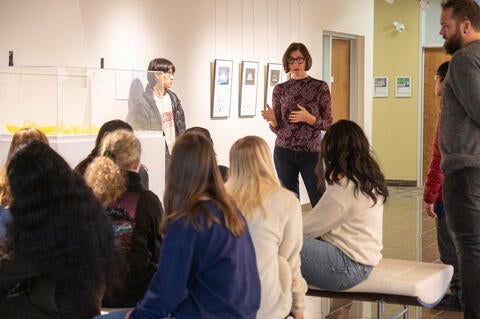On July 16, 1945, the United States Army successfully detonated the first atomic bomb in a New Mexico desert. Codenamed Trinity, the test marked a pivotal moment in history, as it demonstrated the feasibility of atomic weapons – ultimately leading to the bombings of Hiroshima and Nagasaki during World War II.
The recent box office success of Oppenheimer has prompted a new generation to discuss the origins and ongoing dangers of nuclear weapons. Building on this cultural moment, Mary Kavanagh’s exhibit, Trinity, Then and Now, located in the Grebel Gallery, explores the bomb test’s lasting impact in a narrative context.
Trinity, Then and Now walks audiences through archival photographs that display the building of the bomb, uranium glass sculptures, and a documentary video that probes the violent earthly repercussions caused by the morbid relationship between humans and nuclear materials.
The Grebel Gallery serves not only as a stage to explore the relationship between art and peace, but also as a container for thought-provoking conversations. For example, on this year’s International Day of Peace, Cesar Jaramillo from Project Ploughshares talked about the current state of nuclear weaponry and non-proliferation sixty years after the Cuban Missile Crisis with Masters of Peace and Conflict Studies students and other community members. Trinity, Then and Now provided an evocative backdrop and reminder of the harrowing legacy of nuclear warfare.
The exhibition will be on display until February 2024. Visitors are invited to drop in and see Trinity, Then and Now during the Gallery’s regular hours, Monday through Thursday from 8:30 am to 10:00 pm, and until 6:00 pm on Fridays.

Artist Mary Kavanagh speaks with a Peace and Conflict Studies class.






